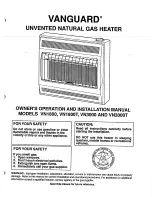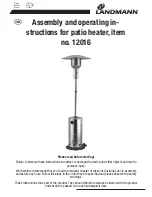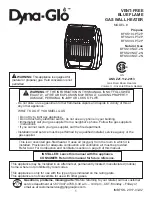
507858-01
Issue 1922
Page 5 of 21
2. For U.S. installations, the vent system shall terminate
a minimum horizontal clearance of 4’ from electric
meters, regulators, and relief equipment. For
installations in Canada, refer to the current CAN/
CGA-B149.1 & .2 or with the authorities having local
jurisdiction.
3. Flue products from properly adjusted and maintained
units, will not cause degradation to building materials.
The unit contains an exhaust blower. The blower draws the
combustion products out of the heat exchanger together
with dilution air and forces the mixture from the unit to the
outside. No special provisions are required for supplying
air for combustion, nor is a chimney required.
The vent outlet must be extended (see Vent Pipe
Installation).
The venting system is designed for proper operation under
all weather conditions and for winds up to 40 miles per
hour, and should be unobstructed for a minimum of 2 feet.
Existing Venting Systems
When an existing furnace is removed and replaced, the
MGE4 unit venting system may no longer be sized to
properly vent the attached appliances. An improperly sized
venting system can result in spillage of flue products into
the living space, the formation of condensate, leakage, etc.
Refer to the
WARNING
box in the next column for proper
test procedure.
Vent Pipe Installation
Determining the length of the vent pipe extension is
dependent upon which wall sleeve accessory is installed
at the job site for each particular installation.
For proper operation, the vent length must be correct for
the installation. The unit may not operate correctly with
inadequate vent length.
CAUTION
1. Access vent pipe at the side of the unit that will face
the outdoors.
2. The vent pipe and vent pipe extension is located to the
right of the outdoor fan (see Figure 3).
Figure 3.
Locating Vent Pipe and Extension
Mounting
Bracket
Vent Pipe
Outdoor Fan
3. Remove the 5/16” screw used to mount the vent pipe
assembly to the mounting bracket. Keep this screw.
Carbon Monoxide Poisoning Hazard
Failure to follow the steps outlined below for each
appliance connected to the venting system being
placed into operation could result in carbon monoxide
poisoning or death.
The following steps shall be followed for each appliance
connected to the venting system being placed into
operation, while all other appliances connected to the
common venting system are not in operation:
1. Seal any unused openings in the common venting
system.
2. Visually inspect the venting system for proper size
and horizontal pitch, as required in the National
Fuel Gas Code, ANSI Z223.1/NFPA 54 (latest
edition) or the CSA B149.1, Natural Gas and
Propane Installation Codes and these instructions.
Determine that there is no blockage or restriction,
leakage, corrosion, or other deficiencies which
could cause an unsafe condition.
3. As far as practical, close all building doors
and windows between the space in which the
appliance(s) connected to the venting system are
located and other spaces in the building.
4.
Close fireplace dampers.
5. Turn on clothes dryers and any appliance not
connected to the venting system. Turn on any
exhaust fans, such as range hoods and bathroom
exhausts, so they are operating at maximum speed.
Do not operate a summer exhaust fan.
6. Follow the lighting instructions. Place the unit being
inspected in operation. Adjust the thermostat so
appliance is operating continuously.
7. Test for spillage from draft hood equipped
appliances at the draft hood relief opening after 5
minutes of main burner operation. Use the flame of
a match or candle.
8. If improper venting is observed during any of the
above tests, the venting system must be corrected
in accordance with the National Fuel Gas Code,
ANSI Z223.1/NFPA 54 (latest edition) and/or the
CSA B149.1, Natural Gas and Propane Installation
Codes.
9. After it has been determined that each appliance
remaining connected to the venting system properly
vents when tested as outlined above, return doors,
windows, exhaust fans, fireplace dampers, and any
other gas-fired burning appliance to their previous
conditions of use.
CAUTION






































